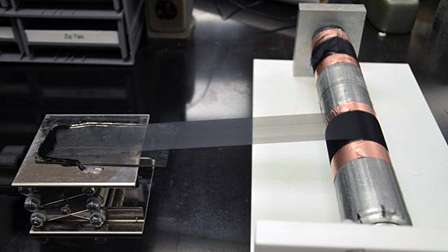Battery design gets boost from aligned carbon nanotubes

Researchers at North Carolina State University have created a new flexible nano-scaffold for rechargeable lithium ion batteries that could help make cell phone and electric car batteries last longer.
The research, published in Advanced Materials, shows the potential of manufactured sheets of aligned carbon nanotubes coated with silicon, a material with a much higher energy storage capacity than the graphite composites typically used in lithium ion batteries.
"Putting silicon into batteries can produce a huge increase in capacity—10 times greater," said Dr. Philip Bradford, assistant professor of textile engineering, chemistry and science at NC State. "But adding silicon can also create 10 times the problems."
One significant challenge in using silicon is that it swells as lithium ion batteries discharge. As the batteries cycle, silicon can break off from the electrode and float around (known as pulverization) instead of staying in place, making batteries less stable.
When the silicon-coated carbon nanotubes were aligned in one direction like a layer of drinking straws laid end to end, the structure allowed for controlled expansion so that the silicon is less prone to pulverization, said Xiangwu Zhang, associate professor of textile engineering, chemistry and science at NC State.

"There's a huge demand for batteries for cell phones and electric vehicles, which need higher energy capacity for longer driving distances between charges," Zhang said. "We believe this carbon nanotube scaffolding potentially has the ability to change the industry, although technical aspects will have to be worked out. The manufacturing process we're using is scalable and could work well in commercial production."
More information: "Aligned Carbon Nanotube-Silicon Sheets: A Novel Nano-architecture for Flexible Lithium Ion Battery Electrodes" Online Aug. 1 in Advanced Materials onlinelibrary.wiley.com/doi/10 … /adma.201301920/full
Abstract
In the pursuit of high performance lithium ion batteries (LIBs), significant effort has been expended to explore high performance cathode and anode materials. Silicon has the greatest lithium storage capacity per unit mass, and is therefore one of the most promising potential candidates to replace graphite as the anode material in future generations of batteries. The main challenge in utilizing silicon comes from the structural failure induced by its large volume change (>300%) during electrochemical cycling, leading to capacity loss. New designs, in which silicon and carbon can act in a mutually beneficial way, so that silicon can fully contribute to the capacity while maintaining cyclic stability, are needed. With this in mind, this communication describes novel, binder-free, thin sheet anodes for LIBs using aligned carbon nanotube (CNT) based silicon films which were processed in a way that is conducive to future commercial production. The horizontal super-aligned CNT sheets provided high surface area and a porous structure to facilitate both the uniform chemical vapor deposition of silicon during fabrication and the electrochemical kinetics between the silicon and the electrolyte during use. The CNT-based silicon composite sheets had both high specific energy capacity and stable cycle performance. This work also revealed an interesting new mechanism of deformation for silicon coated CNT structures after electrochemical cycling. A spring-like deformation behavior of the aligned CNTs helped to explain the electrochemical stability of the crystalline silicon coatings. These findings will guide future work to optimize this unique nano-architecture for further increases in energy density and stability. This aligned CNT scaffold design may be extended to other anode and cathode materials utilized in thin and flexible LIBs.
Journal information: Advanced Materials
Provided by North Carolina State University




















